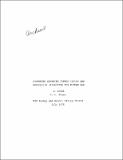| dc.contributor.author | Gruhl, Jim | |
| dc.contributor.author | Sotak, Arthur E. | |
| dc.date.accessioned | 2006-03-13T16:00:27Z | |
| dc.date.available | 2006-03-13T16:00:27Z | |
| dc.date.issued | 1978-07 | |
| dc.identifier.other | 04830534 | |
| dc.identifier.uri | http://hdl.handle.net/1721.1/31331 | |
| dc.description.abstract | This report lists and discusses the types of information that are
necessary for making decisions about the allocation of R&D funds among
various electric power related energy technologies. The discussion is
divided into two parts: (1) the task of choosing among different
technologies and (2) the task of guiding toward the most important specific
projects within an individual technology. To choose among alternative
energy technologies requires assumptive information, assessment infor-
mation, probabilistic information, and techniques for quantifying the
overall desirability of each alternative. Guidance toward the most
important projects requires information about levels and uncertainties of
certain performance measures and their importance relative to external
thresholds or relative to the performance of competing technologies. Some
simple examples are presented to illustrate the discussion. A bibliography
of more than 200 important references in this field was compiled and is
appended to this report. | en |
| dc.description.sponsorship | Sponsored by U.S. Environmental Protection Agency, Contract #68-02-2146. | en |
| dc.format.extent | 3129491 bytes | |
| dc.format.mimetype | application/pdf | |
| dc.language.iso | en_US | en |
| dc.publisher | MIT Energy Laboratory | en |
| dc.relation.ispartofseries | MIT-EL | en |
| dc.relation.ispartofseries | 78-030 | en |
| dc.subject | Research and development contracts |z United States. | en |
| dc.subject | Technology assessment |z United States. | en |
| dc.title | Comparing advanced energy cycles and developing priorities for future R&D | en |
| dc.type | Technical Report | en |
